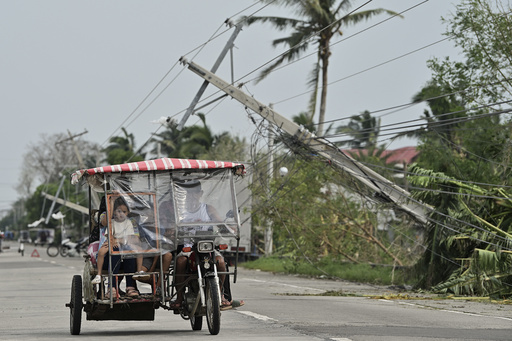
Thousands of individuals are currently facing mandatory evacuations from approximately 2,500 villages located in the northern Philippines as another typhoon looms over a region already scarred by recent floods and landslides caused by three storms within the past month.
Typhoon Toraji is projected to traverse the mountainous areas of Luzon, where President Ferdinand Marcos Jr. had conducted an inspection just a day prior to assess the impact of the latest storm and oversee food distribution efforts for affected residents. To prioritize recovery from the consecutive storms, Marcos opted out of attending this week’s Asia-Pacific Cooperation forum in Peru.
As of Monday morning, Toraji was situated around 100 kilometers (approximately 62 miles) east of Casiguran town in the northeastern Aurora province, featuring sustained winds reaching up to 130 kilometers (81 miles) per hour, with gusts hitting 180 kph (112 mph). The typhoon is expected to advance northwest across Luzon, likely diminishing in strength after crossing the mountainous terrain before entering the South China Sea.
On Sunday, Interior Secretary Jonvic Remulla mandated the evacuation of communities vulnerable to the impending storm, which is locally known as Nika. He cautioned that the rain-saturated mountains, valleys, and plains of Luzon were particularly prone to flash floods and landslides. Given the speed at which the typhoon is approaching, officials stressed the urgency of moving large populations to safety.
“We recognize that some individuals may choose to remain, but our priority is to ensure their safety,” Remulla stated to reporters.
The last two typhoons and a tropical storm have collectively resulted in over 160 fatalities, damaging countless homes and agricultural lands and impacting more than 9 million residents. Many individuals were forced to evacuate to emergency shelters after a phenomenal amount of rainfall accumulated, equivalent to one to two months’ worth of precipitation, within just 24 hours in several localities.
In light of the overwhelming damage, the Philippines has received aid from Southeast Asian nations, spearheaded by Singapore, along with assistance from the United States, aimed at delivering food, water, and other necessary supplies to the severely affected regions in the north.
The Philippine archipelago, notorious for its susceptibility to natural disasters such as typhoons and earthquakes, is home to over a dozen active volcanoes, making it one of the countries most at risk for natural calamities globally.
In 2013, Typhoon Haiyan, notorious for being one of the most potent tropical cyclones on record, resulted in more than 7,300 people being reported dead or missing, devastated entire neighborhoods, and caused ships to collide with houses across the central Philippines.
